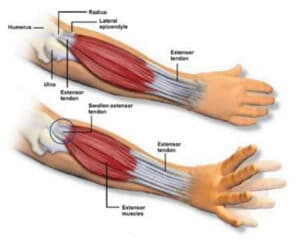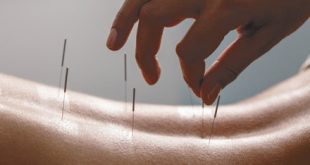

When it comes to tennis players there is a common number of events that are typically found in the history prior to developing Tennis Elbow, here are a few examples:
1. Beginners often practice too long without paying too much attention to the racquet they use.
2. Someone returning to the sport after a period of inactivity and not coming back gradually
to their usual volume of play.
3. For the ones that have played for a while, switching racquets and/or strings, racquets that have higher stiffness combined with higher tension and less forgiving string materials are a dangerous combination.
4. Working on classes or training sessions focuses on strokes like backhand, serves or overheads, they all place an increased load on the wrist extensors at some point causing increased mechanical loading on the side of the elbow.
5. Painters, plumbers, carpenters, are also prone to developing tennis elbow, since they perform repetitive movements against resistance for extended periods of time.
Keep in mind that due to the anatomy and the biomechanics of our upper extremities, the faulty movements at the wrist are the ones at the beginning of this chain reaction leading to problems at the elbow. The most commonly involved muscle group is the ECRB, that runs from the lateral side of the elbow down to the wrist.
Treatment Options
The first step to ensure proper treatment is to visit an MD, who will rule out any other issues and establish the best plan of care that in most cases is conservative care.
This approach might include further testing like an MRI, EMG or X-Ray and then the recommendation of medication, rest, steroid injection, a brace, PRP (platelet rich plasma) injection and Physical Therapy. Most cases of tennis elbow resolve well with a conservative approach only very few will require a surgical approach. Nevertheless, for some patients the rehabilitation process could be long and frustrating, lasting for several months.
Physical Therapy
The main goals of the PT approach include:
1. To relieve pain by improving range of motion, stability and muscle activity in the involved area. Therapists utilize manual therapy interventions, also modalities like ultrasound combined with electrical stimulation and the most adequate exercises to ensure faster recovery.
2. To address flexibility and movement patterns not only of the wrist and elbow but the entire movement chain, which includes the neck and shoulder.
3. To provide a gradual return to full function, including specific recommendations for tennis return including type of strings and their tension, a personal plan to gradually and successfully prevent set-backs due to doing too much too soon.
The team approach has the highest odds of success when dealing with the nagging tennis elbow, a coordinated work from the Medical Doctor, Physical Therapist, Tennis Pro, Personal Trainer and others will offer the best results. In my personal experience patients that have utilized this team approach will more likely recover faster and also have less risk of reoccurrence.
239.213.4295
www.physicaltherapyofnaples.com
 Southwest Florida's Health and Wellness Magazine Health and Wellness Articles
Southwest Florida's Health and Wellness Magazine Health and Wellness Articles

